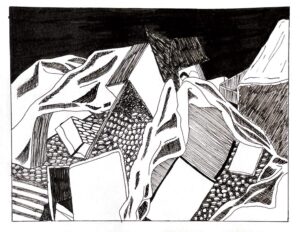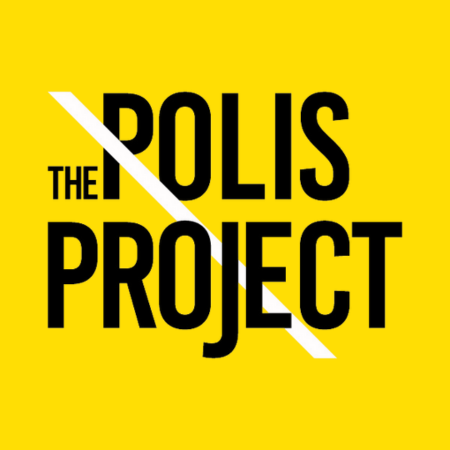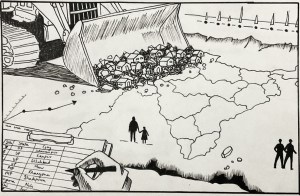
Amid the war on Gaza, Israel’s slow suffocation of the occupied West Bank

Hamdan Ballal recently learnt that an Oscar does not protect one from Zionists. It does not shield you from the crack of a rifle butt against your skull or the boot pressed into your ribs. Weeks after winning the honour for No Other Land, a documentary exposing the erasure of Palestinian communities, the filmmaker Ballal found himself living the very story he had told.
When masked settlers stormed his neighbour’s home, in the village of Susiya, he did what he had always done—he documented. When he tried to film Israeli settlers attacking his neighbour’s house, they followed Ballal home. A soldier joined in as a settler beat him viciously, kicking him on the head after he fell to the ground. Instead of receiving treatment, he was blindfolded, handcuffed and taken to a military base, disappeared for more than 20 hours, where they mocked his Oscar as they beat him further.
The world paid attention because Ballal had just won an Oscar. Susiya is located in rural Masafer Yatta region of the occupied West Bank, which is also the subject of the award-winning documentary. Ballal was a victim of the same violence depicted in his film, and for thousands of Palestinians across the West Bank, this kind of violence is routine. There have been multiple such incidents of violence immediately preceding and following the assault on Ballal, all of which have almost entirely evaded any media attention.
Just days before the assault and detention of Ballal, a journalist known to me, who requested to remain anonymous for security reasons, was abducted alongside two others by Israeli forces near a settler outpost. They were documenting attacks by settlers on Palestinian farmers when IDF soldiers arrived abruptly. Blindfolded and handcuffed, they were taken to an undisclosed location.
For five days, their families had no idea where they were or whether they were even alive. They were denied legal representation or contact with their loved ones. The journalist later recounted to me how they were interrogated for hours on end. They were accused of inciting unrest simply for filming settler violence and subjected to sleep deprivation as part of their detention.

On 7 April, Alaa Hathaleen and his family, also residents of Masafer Yatta, were attacked by over 50 settlers. “I wasn’t even resisting, I wasn’t filming, I wasn’t speaking,” Hathaleen said. “I was just trying to live quietly on my land. And they came for me anyway.”
“They beat me brutally,” he recounted. “The soldiers and police arrived but not to help. They protected the settlers. I was lying on the ground, bloodied, unable to move, and they didn’t care. They let it happen.”
Two days before the attack, Hathaleen had decided to leave social media. “I thought, what’s the point? Nothing changes. But today … things changed for the worse. I became a target even when I tried to live in peace.”
For Palestinians, there is no right way to exist. Under occupation, there are no safe choices. Speak out, and you risk punishment. Stay silent, and the violence finds you anyway. Another Palestinian illegally detained; another night of unchecked violence.
The occupied West Bank has long been framed as the quieter counterpart to Gaza. This framing is dangerously misleading. The images of bombed neighbourhoods, mass displacement, and relentless airstrikes dominate headlines, galvanising international attention. But while Gaza burns under the spotlight, the occupied West Bank is dismantled piece by piece—its suffering no less acute, its crisis no less urgent.
What is unfolding in the region today is a systematic campaign of displacement and dispossession, designed to erase Palestinian presence from their ancestral lands. It’s a war waged not just on homes and infrastructure but on narratives, dignity, and the very possibility of Palestinian sovereignty. And yet, it remains invisible to much of the world.
Since January 2025, two days after the brief ceasefire in Gaza came into effect, Israel has intensified its military operations across the occupied West Bank under “Operation Iron Wall.” In a mission purportedly aimed at quashing armed resistance in the West Bank, over 40,000 Palestinians have been displaced, the largest exodus since 1967. Entire neighbourhoods have been levelled, refugee camps emptied, and infrastructure systematically dismantled. But while Gaza burns in full view, the West Bank’s tragedy unfolds quietly, piecemeal, and often without cameras to capture it.
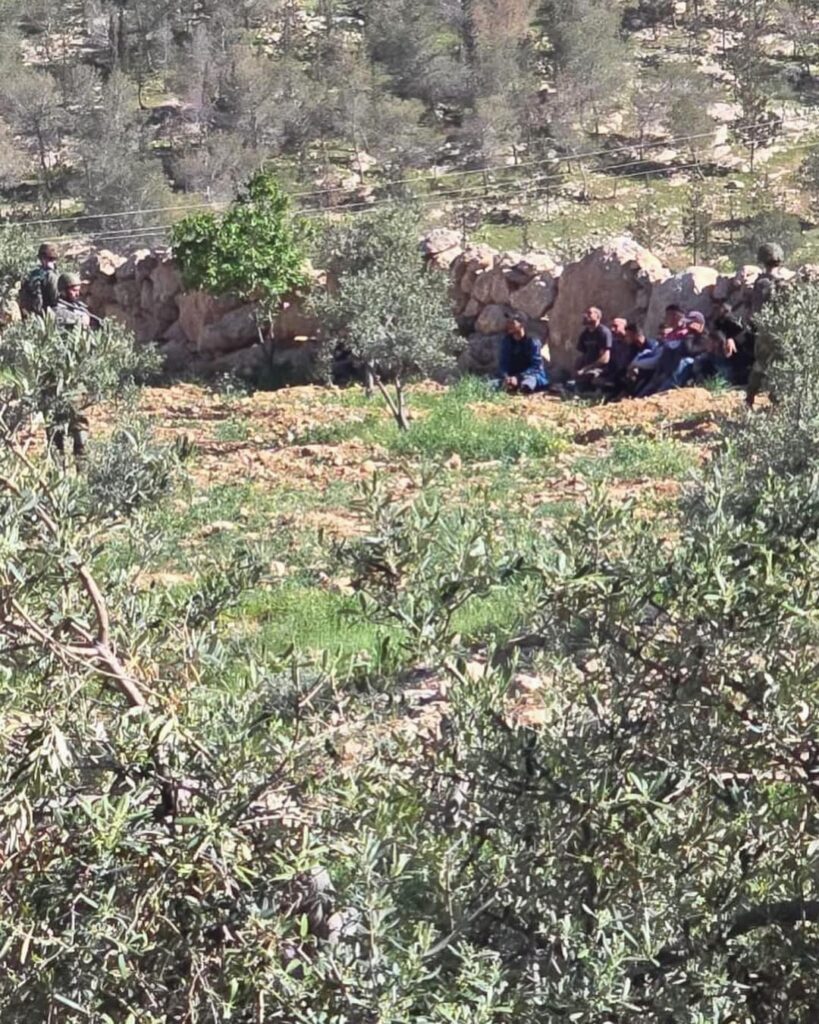
A refugee camp that refuses to disappear
Jenin has become ground zero for Israel’s campaign in the occupied West Bank. The refugee camp, once home to around 14,000 people, now lies in ruins. Drone-fired flares light up the night skies as armoured bulldozers tear through homes and streets. Families flee with whatever they can carry—medicine, school certificates, photo albums—leaving behind a wasteland of rubble and twisted metal.
“This is the third time we have fled since January,” Samah, a Palestinian mother, told me. “But there is nowhere left to go. Not anymore.”
Since 21 January 2025, at least 70 Palestinians have been killed in Jenin alone, with dozens more injured. Across the West Bank, since 7 October 2023, at least 935 Palestinians have been killed and over 7,000 injured in attacks by Israeli forces and settlers. According to the Jenin municipality, 100% of the streets in the camp and 80% of those in the city have been destroyed. More than 3,200 homes have been abandoned as families flee to nearby villages or overcrowded shelters within Jenin city. Food shortages are widespread as commercial areas have been destroyed. Displaced families struggle to access clean water or basic supplies while living in overcrowded conditions.
The war on Palestinian existence isn’t just fought with bullets and bombs, it’s waged against the very ability to survive. Nowhere is this clearer than in the occupied West Bank’s collapsing healthcare system.
In Jenin, Israeli forces recently laid siege to a Palestinian government hospital and the surrounding refugee camp, pounding the area with airstrikes and explosive devices. At least 10 people were killed, more than 40 injured. But Israel’s intention is not just claiming Palestinian lives, but to cripple the very system meant to save them. “They are not fighting militants,” said Tareq Khalil, a surgeon at Jenin Government Hospital. “They are fighting an entire population. The goal is to make life so unbearable that we leave.”
Every ambulance ride is a gamble, with Israeli checkpoints deciding who makes it to the hospital in time and who doesn’t. Emergency medical workers, already stretched thin, find themselves operating under siege conditions. According to Médecins Sans Frontières, trauma stabilisation points within the Jenin refugee camp, which are critical lifelines for the injured, have been repeatedly targeted by drone strikes or destroyed by ground troops. By stripping away healthcare, Israel dismantles the Palestinians’ ability to survive in their own land.
The Jenin refugee camp has long been a symbol of Palestinian resistance. Established for families displaced during the 1948 Nakba (The Catastrophe), it has historically served as a stronghold for groups opposing Israeli occupation. This legacy has made it a target for repeated incursions over the years, but none as extensive as the current operation. Palestinian journalists attempting to document these atrocities face arrests, harassment, and even live fire from Israeli forces. Last month alone saw multiple detentions of journalists covering raids in the Jenin refugee camp and other regions.
Jenin, like so many Palestinian cities before it, is being turned into a shell of itself. Bureaucracy and blockades do the work of erasure in the West Bank, while bombs and bullets make headlines in Gaza.
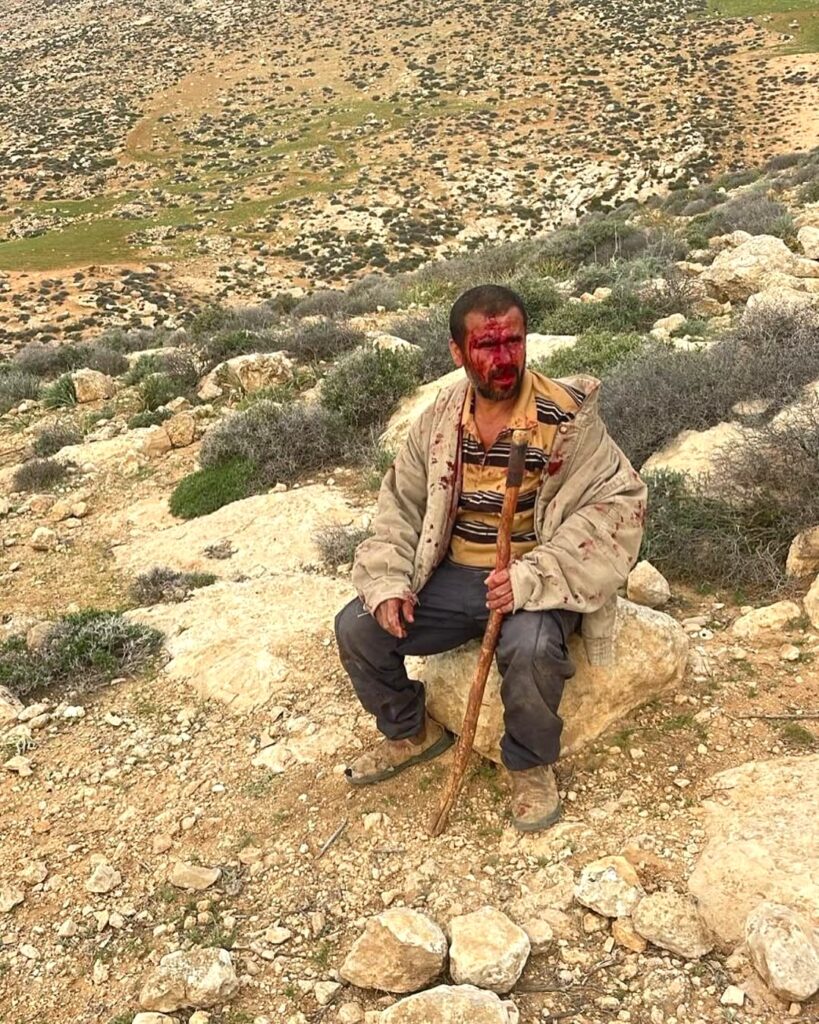
Where the land remembers its people
Masafer Yatta, a cluster of 19 Palestinian hamlets in the South Hebron Hills, is one of the most vulnerable areas in the West Bank. Located between 14 and 24 kilometres south of Hebron, this community has been under constant threat since the Israeli military designated it as “Firing Zone 918” in the early 1980s. This designation, ostensibly for military training purposes, has been used as a pretext to systematically displace Palestinians from their ancestral lands. Despite decades of legal battles and international condemnation, the situation has worsened dramatically since May 2022, when Israel’s Supreme Court ruled that the army could evict residents from eight villages within the firing zone.
Just four days after the assault on Ballal, on 28 March, settlers launched another vicious attack in the village of Jinba, in southwestern Masafer Yatta. “This is not the first time,” said Mahmoud J Makhamreh, a teacher and photographer from the village. “But this time, they ruined everything.” Two settlers attacked Makhamreh’s uncle and cousin while they were herding sheep near the edge of the village. “They beat them badly. We had to rush them to the hospital.”
Makhamreh’s house was among those attacked. “They smashed the windows,” he said. “We had to sleep in the cold. We got sick.” Later that day, dozens of settlers arrived in vehicles and launched an organised assault. “They went straight for Aziz Rabi’s house,” he recounted. “They beat him and his two sons. One needed head surgery. The other has a broken hand. Even the little girl in the house was terrified. Then they started attacking the young men of the village.”
Israeli soldiers entered soon after. “They arrested 22 people. Fifteen were released later, but seven are still being held. Those who got out had to pay 35,000 shekels”—around USD 11,000.
The next day, just after 10 pm, another wave of violence followed. “Hundreds of settlers came back, this time with soldiers,” Makhamreh said. “They smashed every surveillance camera in the village. Then they went from house to house, breaking windows, doors, cars—anything they could reach. They stormed the school, broke the classroom windows, tore up the health clinic, and even trashed the food and supplies.”
Makhamreh added that many of the settlers were disguised. “Some of them were dressed as soldiers,” he said. “Settlers dressed as army personnel too. You couldn’t tell who was who.”
“They want us gone,” Makhamreh said.
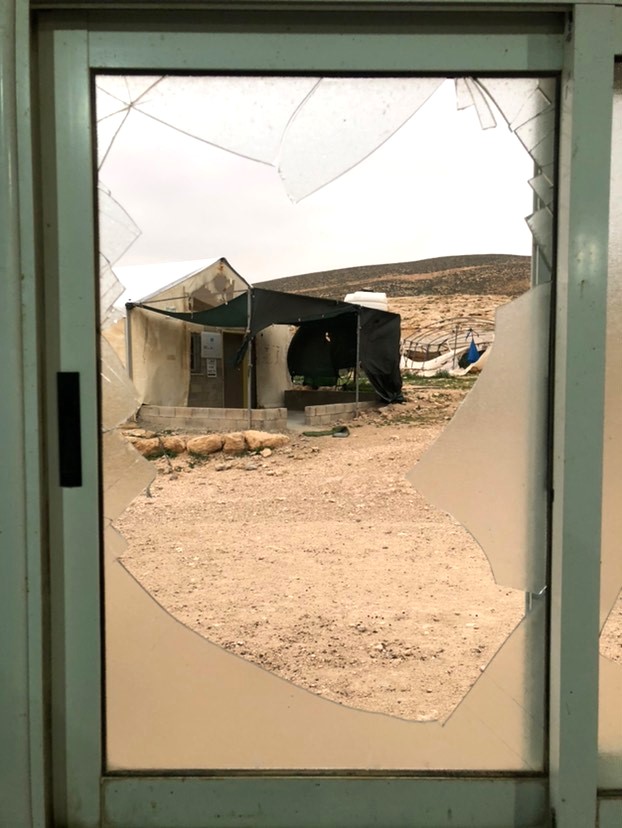
The tactics employed to displace Palestinians in Masafer Yatta are multifaceted. Residents live under constant threat of home demolitions, restrictions on movement, and settler violence. Water cisterns essential for survival in this arid region are routinely destroyed or vandalised. Solar panels—the only source of electricity for many families—are confiscated. Military training exercises often take place dangerously close to residential areas, with live ammunition and explosives further degrading infrastructure and access to basic services.
“For 40 years, we have been resisting,” Sami H Huraini, a Palestinian activist from the region, told me. “They want to push us into cities, into cages surrounded by gates. But this land is our history. We won’t leave.”
The residents of Masafer Yatta primarily rely on herding sheep and goats for their livelihoods. However, Israeli authorities have imposed severe restrictions on grazing lands and access to water sources. The lack of building permits, which is almost impossible for Palestinians to obtain under Israeli military law, means that any construction or development is deemed illegal, leaving homes, schools, clinics, and animal shelters vulnerable to demolition orders.
Meanwhile, settler violence has escalated sharply in Masafer Yatta over the past year—as documented in No Other Land, and endured by Ballal last month. Armed settlers frequently raid villages under military protection, attacking residents and destroying property. According to United Nations data, incidents of settler violence have doubled since October 2023, rising from an average of three incidents per month to nearly six per month in early 2025.
In three separate incidents between 31 July and 4 August 2024, settlers uprooted 140 olive trees and grapevines in Umm Fagarah, a community within Masafer Yatta. During these attacks, settlers cut fencing around agricultural land, set fire to structures, destroyed farming equipment, and vandalised property.
Multiple residents told me how settlers often arrive armed and sometimes dressed in military uniforms to intimidate villagers. Between February and March 2025 alone, five Palestinian herding families comprising 39 people, including 19 children, were forcibly displaced due to recurrent settler violence and military raids. And then there are the military drills. Since late 2023, Israeli forces have escalated live-fire exercises within these villages, deliberately setting up targets near homes and grazing lands.
For decades, the Israeli government has worked to make life untenable for Palestinians in this rural stretch of the occupied West Bank. Life under these policies, Sami explained, is suffocating. “First, they designated it as Area C, where Israel has full military and civil control. Then, they declared a big part of it a firing zone for military training. The goal is to take control of more land. This is more than 60% of the West Bank.”
He continued, “Imagine living in a place where tanks roll through your land, helicopters hover overhead, and soldiers raid your home in the middle of the night—not for any crime, but because they have turned our villages into training grounds. This has been our reality for decades.”
Sami’s family, like so many others, has faced relentless harassment. In the last week of March, they were attacked and forced off their land while they were simply trying to work. Israeli forces raid their home regularly. At night, the army storms the village, firing sound bombs to terrorise the community. “They want to break us down, make us give up,” he said. “This is ethnic cleansing.”
Even the dead are now waiting alongside the living. With Israel withholding burial rights, bodies are being stored in overflowing refrigerators, stacked in limbo as families wait—sometimes for weeks, sometimes for years—never knowing when they will be allowed to lay their loved ones to rest. “It’s a way to control us even in death,” Sami said.
The current military operation, according to him, is unlike any before. “It’s not just about Masafer Yatta. The north of the West Bank, the refugee camps, all are under siege. We are seeing a level of destruction we haven’t seen before. In the last two weeks alone, it’s been terrifying. House demolitions, mass arrests, military raids. Israel is determined to eliminate all forms of resistance.”
Since 7 October 2023, it is estimated that at least 50 Palestinian villages in the West Bank have been emptied, their residents displaced. “And if the world keeps looking away,” Sami warned, “it won’t stop there.”
What’s happening today is an acceleration of decades-long policies aimed at dispossession. Since occupying the West Bank in 1967, Israel has established over 130 settlements, housing more than half a million Israelis. These settlements, considered illegal under international law, have carved the territory into isolated enclaves, while military checkpoints restrict Palestinian movement and economic development.
Over the years, Israel has introduced legal mechanisms to entrench this reality—from retroactively legalising settlements built on private Palestinian land, to pushing for annexation in and around Jerusalem. Though some measures, like a law on land regularisation, have been struck down by Israeli courts, settlement expansion continues.
There is no dramatic breaking news banner for the slow suffocation of a people. There are no images of fireballs engulfing buildings, no air raid sirens blaring in the background. The daily violence of occupation, the home raids at dawn, the water sources confiscated, the families pushed into exile rarely make front pages. In the process, the absence of spectacle becomes a tool of war. The quiet, relentless machinery of displacement: a family forced to pack their belongings before a bulldozer arrives; a shepherd finding his grazing land fenced off overnight; a child walking for miles to school because the nearest one has been demolished. It does not happen all at once, and that is precisely the point.
Every act is designed to make Palestinian survival a question of endurance, to make existence itself exhausting. And yet, despite everything, they remain. For every village erased, another resists. For every home demolished, another is rebuilt. For every attempt to make life unlivable, there is defiance in simply staying.
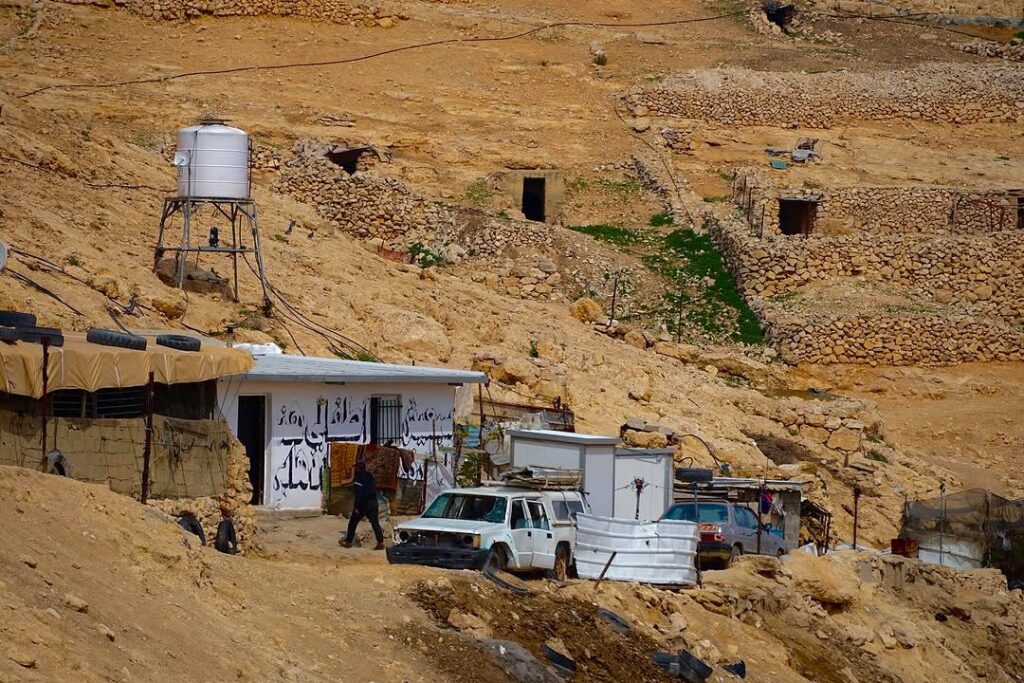
In Masafer Yatta, families wake each morning not knowing if their homes will still be standing by nightfall. In Jenin, residents return to the rubble of their neighbourhoods and begin clearing the debris by hand. In villages where settlers have burned olive trees, Palestinians return to replant them. To live under occupation is to refuse to vanish, to stake a claim to dignity when every system is built to deny it.
The story of Palestine is often told through numbers—how many homes destroyed, how many acres lost, how many lives taken. But the real story is in what cannot be measured—the resilience of those who stay. “They want to break the will of those who refuse to leave,” Sami said. And yet, leaving is not an option for Palestinians. “We know how hard this moment is. We will continue to exist. This is our land, and we will protect it. No matter how much they try to erase us, we just have to hold on.”
Related Posts
Amid the war on Gaza, Israel’s slow suffocation of the occupied West Bank

After Israeli extremist settlers attacked residents in Khallat Al-Dabea, Masafer Yatta, Israeli forces arrived, and arrested at least three Palestinians and three international activists. PHOTO COURTESY SAMI H HURAINI
Hamdan Ballal recently learnt that an Oscar does not protect one from Zionists. It does not shield you from the crack of a rifle butt against your skull or the boot pressed into your ribs. Weeks after winning the honour for No Other Land, a documentary exposing the erasure of Palestinian communities, the filmmaker Ballal found himself living the very story he had told.
When masked settlers stormed his neighbour’s home, in the village of Susiya, he did what he had always done—he documented. When he tried to film Israeli settlers attacking his neighbour’s house, they followed Ballal home. A soldier joined in as a settler beat him viciously, kicking him on the head after he fell to the ground. Instead of receiving treatment, he was blindfolded, handcuffed and taken to a military base, disappeared for more than 20 hours, where they mocked his Oscar as they beat him further.
The world paid attention because Ballal had just won an Oscar. Susiya is located in rural Masafer Yatta region of the occupied West Bank, which is also the subject of the award-winning documentary. Ballal was a victim of the same violence depicted in his film, and for thousands of Palestinians across the West Bank, this kind of violence is routine. There have been multiple such incidents of violence immediately preceding and following the assault on Ballal, all of which have almost entirely evaded any media attention.
Just days before the assault and detention of Ballal, a journalist known to me, who requested to remain anonymous for security reasons, was abducted alongside two others by Israeli forces near a settler outpost. They were documenting attacks by settlers on Palestinian farmers when IDF soldiers arrived abruptly. Blindfolded and handcuffed, they were taken to an undisclosed location.
For five days, their families had no idea where they were or whether they were even alive. They were denied legal representation or contact with their loved ones. The journalist later recounted to me how they were interrogated for hours on end. They were accused of inciting unrest simply for filming settler violence and subjected to sleep deprivation as part of their detention.

On 7 April, Alaa Hathaleen and his family, also residents of Masafer Yatta, were attacked by over 50 settlers. “I wasn’t even resisting, I wasn’t filming, I wasn’t speaking,” Hathaleen said. “I was just trying to live quietly on my land. And they came for me anyway.”
“They beat me brutally,” he recounted. “The soldiers and police arrived but not to help. They protected the settlers. I was lying on the ground, bloodied, unable to move, and they didn’t care. They let it happen.”
Two days before the attack, Hathaleen had decided to leave social media. “I thought, what’s the point? Nothing changes. But today … things changed for the worse. I became a target even when I tried to live in peace.”
For Palestinians, there is no right way to exist. Under occupation, there are no safe choices. Speak out, and you risk punishment. Stay silent, and the violence finds you anyway. Another Palestinian illegally detained; another night of unchecked violence.
The occupied West Bank has long been framed as the quieter counterpart to Gaza. This framing is dangerously misleading. The images of bombed neighbourhoods, mass displacement, and relentless airstrikes dominate headlines, galvanising international attention. But while Gaza burns under the spotlight, the occupied West Bank is dismantled piece by piece—its suffering no less acute, its crisis no less urgent.
What is unfolding in the region today is a systematic campaign of displacement and dispossession, designed to erase Palestinian presence from their ancestral lands. It’s a war waged not just on homes and infrastructure but on narratives, dignity, and the very possibility of Palestinian sovereignty. And yet, it remains invisible to much of the world.
Since January 2025, two days after the brief ceasefire in Gaza came into effect, Israel has intensified its military operations across the occupied West Bank under “Operation Iron Wall.” In a mission purportedly aimed at quashing armed resistance in the West Bank, over 40,000 Palestinians have been displaced, the largest exodus since 1967. Entire neighbourhoods have been levelled, refugee camps emptied, and infrastructure systematically dismantled. But while Gaza burns in full view, the West Bank’s tragedy unfolds quietly, piecemeal, and often without cameras to capture it.

A refugee camp that refuses to disappear
Jenin has become ground zero for Israel’s campaign in the occupied West Bank. The refugee camp, once home to around 14,000 people, now lies in ruins. Drone-fired flares light up the night skies as armoured bulldozers tear through homes and streets. Families flee with whatever they can carry—medicine, school certificates, photo albums—leaving behind a wasteland of rubble and twisted metal.
“This is the third time we have fled since January,” Samah, a Palestinian mother, told me. “But there is nowhere left to go. Not anymore.”
Since 21 January 2025, at least 70 Palestinians have been killed in Jenin alone, with dozens more injured. Across the West Bank, since 7 October 2023, at least 935 Palestinians have been killed and over 7,000 injured in attacks by Israeli forces and settlers. According to the Jenin municipality, 100% of the streets in the camp and 80% of those in the city have been destroyed. More than 3,200 homes have been abandoned as families flee to nearby villages or overcrowded shelters within Jenin city. Food shortages are widespread as commercial areas have been destroyed. Displaced families struggle to access clean water or basic supplies while living in overcrowded conditions.
The war on Palestinian existence isn’t just fought with bullets and bombs, it’s waged against the very ability to survive. Nowhere is this clearer than in the occupied West Bank’s collapsing healthcare system.
In Jenin, Israeli forces recently laid siege to a Palestinian government hospital and the surrounding refugee camp, pounding the area with airstrikes and explosive devices. At least 10 people were killed, more than 40 injured. But Israel’s intention is not just claiming Palestinian lives, but to cripple the very system meant to save them. “They are not fighting militants,” said Tareq Khalil, a surgeon at Jenin Government Hospital. “They are fighting an entire population. The goal is to make life so unbearable that we leave.”
Every ambulance ride is a gamble, with Israeli checkpoints deciding who makes it to the hospital in time and who doesn’t. Emergency medical workers, already stretched thin, find themselves operating under siege conditions. According to Médecins Sans Frontières, trauma stabilisation points within the Jenin refugee camp, which are critical lifelines for the injured, have been repeatedly targeted by drone strikes or destroyed by ground troops. By stripping away healthcare, Israel dismantles the Palestinians’ ability to survive in their own land.
The Jenin refugee camp has long been a symbol of Palestinian resistance. Established for families displaced during the 1948 Nakba (The Catastrophe), it has historically served as a stronghold for groups opposing Israeli occupation. This legacy has made it a target for repeated incursions over the years, but none as extensive as the current operation. Palestinian journalists attempting to document these atrocities face arrests, harassment, and even live fire from Israeli forces. Last month alone saw multiple detentions of journalists covering raids in the Jenin refugee camp and other regions.
Jenin, like so many Palestinian cities before it, is being turned into a shell of itself. Bureaucracy and blockades do the work of erasure in the West Bank, while bombs and bullets make headlines in Gaza.

Where the land remembers its people
Masafer Yatta, a cluster of 19 Palestinian hamlets in the South Hebron Hills, is one of the most vulnerable areas in the West Bank. Located between 14 and 24 kilometres south of Hebron, this community has been under constant threat since the Israeli military designated it as “Firing Zone 918” in the early 1980s. This designation, ostensibly for military training purposes, has been used as a pretext to systematically displace Palestinians from their ancestral lands. Despite decades of legal battles and international condemnation, the situation has worsened dramatically since May 2022, when Israel’s Supreme Court ruled that the army could evict residents from eight villages within the firing zone.
Just four days after the assault on Ballal, on 28 March, settlers launched another vicious attack in the village of Jinba, in southwestern Masafer Yatta. “This is not the first time,” said Mahmoud J Makhamreh, a teacher and photographer from the village. “But this time, they ruined everything.” Two settlers attacked Makhamreh’s uncle and cousin while they were herding sheep near the edge of the village. “They beat them badly. We had to rush them to the hospital.”
Makhamreh’s house was among those attacked. “They smashed the windows,” he said. “We had to sleep in the cold. We got sick.” Later that day, dozens of settlers arrived in vehicles and launched an organised assault. “They went straight for Aziz Rabi’s house,” he recounted. “They beat him and his two sons. One needed head surgery. The other has a broken hand. Even the little girl in the house was terrified. Then they started attacking the young men of the village.”
Israeli soldiers entered soon after. “They arrested 22 people. Fifteen were released later, but seven are still being held. Those who got out had to pay 35,000 shekels”—around USD 11,000.
The next day, just after 10 pm, another wave of violence followed. “Hundreds of settlers came back, this time with soldiers,” Makhamreh said. “They smashed every surveillance camera in the village. Then they went from house to house, breaking windows, doors, cars—anything they could reach. They stormed the school, broke the classroom windows, tore up the health clinic, and even trashed the food and supplies.”
Makhamreh added that many of the settlers were disguised. “Some of them were dressed as soldiers,” he said. “Settlers dressed as army personnel too. You couldn’t tell who was who.”
“They want us gone,” Makhamreh said.

The tactics employed to displace Palestinians in Masafer Yatta are multifaceted. Residents live under constant threat of home demolitions, restrictions on movement, and settler violence. Water cisterns essential for survival in this arid region are routinely destroyed or vandalised. Solar panels—the only source of electricity for many families—are confiscated. Military training exercises often take place dangerously close to residential areas, with live ammunition and explosives further degrading infrastructure and access to basic services.
“For 40 years, we have been resisting,” Sami H Huraini, a Palestinian activist from the region, told me. “They want to push us into cities, into cages surrounded by gates. But this land is our history. We won’t leave.”
The residents of Masafer Yatta primarily rely on herding sheep and goats for their livelihoods. However, Israeli authorities have imposed severe restrictions on grazing lands and access to water sources. The lack of building permits, which is almost impossible for Palestinians to obtain under Israeli military law, means that any construction or development is deemed illegal, leaving homes, schools, clinics, and animal shelters vulnerable to demolition orders.
Meanwhile, settler violence has escalated sharply in Masafer Yatta over the past year—as documented in No Other Land, and endured by Ballal last month. Armed settlers frequently raid villages under military protection, attacking residents and destroying property. According to United Nations data, incidents of settler violence have doubled since October 2023, rising from an average of three incidents per month to nearly six per month in early 2025.
In three separate incidents between 31 July and 4 August 2024, settlers uprooted 140 olive trees and grapevines in Umm Fagarah, a community within Masafer Yatta. During these attacks, settlers cut fencing around agricultural land, set fire to structures, destroyed farming equipment, and vandalised property.
Multiple residents told me how settlers often arrive armed and sometimes dressed in military uniforms to intimidate villagers. Between February and March 2025 alone, five Palestinian herding families comprising 39 people, including 19 children, were forcibly displaced due to recurrent settler violence and military raids. And then there are the military drills. Since late 2023, Israeli forces have escalated live-fire exercises within these villages, deliberately setting up targets near homes and grazing lands.
For decades, the Israeli government has worked to make life untenable for Palestinians in this rural stretch of the occupied West Bank. Life under these policies, Sami explained, is suffocating. “First, they designated it as Area C, where Israel has full military and civil control. Then, they declared a big part of it a firing zone for military training. The goal is to take control of more land. This is more than 60% of the West Bank.”
He continued, “Imagine living in a place where tanks roll through your land, helicopters hover overhead, and soldiers raid your home in the middle of the night—not for any crime, but because they have turned our villages into training grounds. This has been our reality for decades.”
Sami’s family, like so many others, has faced relentless harassment. In the last week of March, they were attacked and forced off their land while they were simply trying to work. Israeli forces raid their home regularly. At night, the army storms the village, firing sound bombs to terrorise the community. “They want to break us down, make us give up,” he said. “This is ethnic cleansing.”
Even the dead are now waiting alongside the living. With Israel withholding burial rights, bodies are being stored in overflowing refrigerators, stacked in limbo as families wait—sometimes for weeks, sometimes for years—never knowing when they will be allowed to lay their loved ones to rest. “It’s a way to control us even in death,” Sami said.
The current military operation, according to him, is unlike any before. “It’s not just about Masafer Yatta. The north of the West Bank, the refugee camps, all are under siege. We are seeing a level of destruction we haven’t seen before. In the last two weeks alone, it’s been terrifying. House demolitions, mass arrests, military raids. Israel is determined to eliminate all forms of resistance.”
Since 7 October 2023, it is estimated that at least 50 Palestinian villages in the West Bank have been emptied, their residents displaced. “And if the world keeps looking away,” Sami warned, “it won’t stop there.”
What’s happening today is an acceleration of decades-long policies aimed at dispossession. Since occupying the West Bank in 1967, Israel has established over 130 settlements, housing more than half a million Israelis. These settlements, considered illegal under international law, have carved the territory into isolated enclaves, while military checkpoints restrict Palestinian movement and economic development.
Over the years, Israel has introduced legal mechanisms to entrench this reality—from retroactively legalising settlements built on private Palestinian land, to pushing for annexation in and around Jerusalem. Though some measures, like a law on land regularisation, have been struck down by Israeli courts, settlement expansion continues.
There is no dramatic breaking news banner for the slow suffocation of a people. There are no images of fireballs engulfing buildings, no air raid sirens blaring in the background. The daily violence of occupation, the home raids at dawn, the water sources confiscated, the families pushed into exile rarely make front pages. In the process, the absence of spectacle becomes a tool of war. The quiet, relentless machinery of displacement: a family forced to pack their belongings before a bulldozer arrives; a shepherd finding his grazing land fenced off overnight; a child walking for miles to school because the nearest one has been demolished. It does not happen all at once, and that is precisely the point.
Every act is designed to make Palestinian survival a question of endurance, to make existence itself exhausting. And yet, despite everything, they remain. For every village erased, another resists. For every home demolished, another is rebuilt. For every attempt to make life unlivable, there is defiance in simply staying.

In Masafer Yatta, families wake each morning not knowing if their homes will still be standing by nightfall. In Jenin, residents return to the rubble of their neighbourhoods and begin clearing the debris by hand. In villages where settlers have burned olive trees, Palestinians return to replant them. To live under occupation is to refuse to vanish, to stake a claim to dignity when every system is built to deny it.
The story of Palestine is often told through numbers—how many homes destroyed, how many acres lost, how many lives taken. But the real story is in what cannot be measured—the resilience of those who stay. “They want to break the will of those who refuse to leave,” Sami said. And yet, leaving is not an option for Palestinians. “We know how hard this moment is. We will continue to exist. This is our land, and we will protect it. No matter how much they try to erase us, we just have to hold on.”
SUPPORT US
We like bringing the stories that don’t get told to you. For that, we need your support. However small, we would appreciate it.



